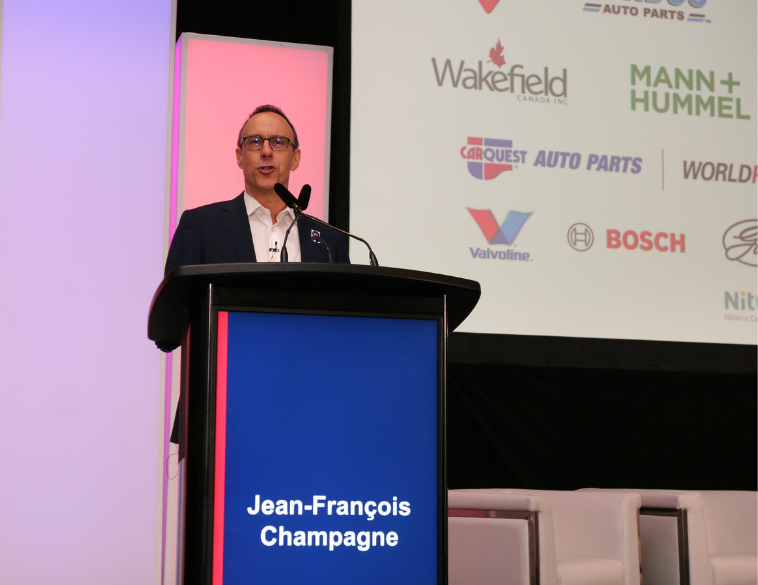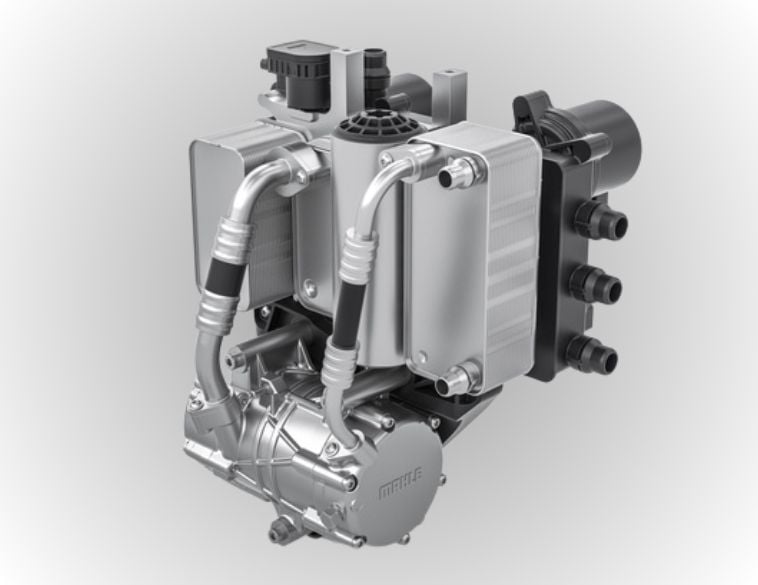Recruitment strategies, career path development and right to repair all key topics.
On April 25-26, AIA Canada held its 2023 National Conference in Toronto. With the Delta by Marriott Toronto Airport at 655 Dixon Road, serving as the venue, the event featured a whole host of general and breakout sessions, as well as plenty of networking opportunities. Among the many attendees we spoke with, there was a consensus of having some fabulous content, information, and ideas to help the auto care industry.
In the opening, AIA Canada Executive team members provided the audience with an update on some of the latest initiatives and programs happening at the association.
Critical information
Jean-François Champagne, President, Alana Baker, Senior Director, Government Relations; Stu Klein, Senior Director, Collision Services and Brendan Mullen, Senior Director, Marketing Communications, all took to the stage. Jean-François Champagne noted that given how fast the automotive sector is currently changing, being able to stay relevant and provide critical information and resources to support the auto care sector is absolutely critical.
On the marketing side, Brendan Mullen explained that AIA Canada has made some very significant changes in outreach and communication strategy. A member-centric approach has resulted in the creation of new websites, programs and research tools to elevate the member experience and provide a more seamless interaction between the association and the auto care industry. “We’ve been really busy over the last 18 months in building a foundation and having the right tools in place to get a better understanding of the value chain and which products and strategies really work. There’s also been a big emphasis on research data and tailoring the results from these findings into concise, actionable reports for different businesses and sectors within the industry, including parts manufacturers and distributors, service providers and collision centres, as well as other key vendors and stakeholders.
Recognized training standards
Speaking of collision, Stu Klein noted that a big push is on training for collision and development for technicians via I-CAR training which is administered in this country by AIA Canada. There’s also a growing need for the industry to look at a national collision repair standard and how programs like those offered through I-CAR are a very effective way for shops to ensure their technicians can stay proficient and current with the latest technology and repair procedures, including ADAS systems, as well as providing them with an opportunity to be recognized at a national level by insurers and other key stakeholders for consistent and quality investments in training, processes and results. Klein also stressed the importance of the role that events like the Canadian Collision Industry Forum (CCIF) have in bringing together thought leaders and industry professionals together to help advance the collision repair industry.
Alana Baker, Senior Director, Government Relations, discussed AIA Canada’s ongoing lobbying efforts at the federal level, including the importance of ensuring that consumers have the right to choose who services and repairs their vehicles. Right to repair legislation is moving forward, but, as Baker stressed, it requires a collective effort in order to succeed. As part of this plan, the association has launched a grassroots campaign where service centres are encouraged to take part and work with local members of parliament to ensure the auto care sector has strength in numbers and a strong voice when it comes to ensuring a fair and level playing field remains for the industry across Canada. Baker also touched upon the current labour and skills shortage impacting the auto care industry and how AIA Canada has and is continuing to secure funding in partnership with the government to deliver innovative training and recruitment programs to attract skilled professionals to this vibrant and exciting sector.
Multiple breakout sessions were a feature of this year’s conference, and six different options were available for attendees, built around three core topics. These comprised of:
- Women in the Aftermarket, with two sessions, one on Leading and Driving results Through Relationship Building, and Breaking Barriers: Inclusivity for Women and Men in Non-Traditional Careers
- Young Professionals in the Aftermarket which comprised of: Modern Leadership and Building a Winning Culture and Leveling Up Your LinkedIn
- Market Research and Data with a Canadian Outlook and Driving to an EV Future and the Evolution of the Customer Experience
The market research sessions contained some very insightful data and analysis. The Canadian Outlook session, presented by Guido Vildozo, Senior Manager, Americas, Light Vehicle Sales Forecasting, S&P Global Mobility, had some very interesting data to share. Firstly, the economic outlook for Canada has improved since late last year, meaning a recession is no longer expected in 2023 and going into 2024. That being said, economic growth—going forward for the next five years—is likely to remain around 1.8-1.9%—which is below what we’ve seen for the last three decades. Inflation is likely to remain sticky for some time, which means higher costs for both consumers and businesses, as well as higher prices for goods such as vehicles. Supply chain disruptions and vehicle component shortages—including semi-conductors—are still significant issues, though, the expectation is that the situation will likely ease during 2024.
EVs and PHEVs
Regarding the hot topic of the moment, vehicle electrification, Vildozo said that globally, Europe continues to push for very aggressive targets of achieving 100% battery-electric vehicle sales by 2035. China, by contrast, is pursuing a different path, with the aim of achieving net zero by 2050. Here in Canada, while the federal government has declared they want 100% electric new vehicle sales by 2035, there are some caveats. Firstly, that does include plug-in-hybrid vehicles (PHEVs) and secondly, with this mandate, the government is deviating from the path of the U.S., which it has traditionally followed. This does have implications, namely that following such a strategy will mean lower sales volumes, higher prices and significant cost and complexity for the auto industry in Canada. Furthermore, with different provinces pursuing EV targets and strategies in different ways and at different rates, it becomes harder to see how ultimately, things will play out. One thing is for sure, the next few years are going to be very interesting.
A second market research session, hosted by J.D. Ney, Automotive Practice Lead, Canada for J.D. Power, discussed how the automotive customer experience has evolved and will continue to as we go forward. Key aspects of this include understanding what’s required to achieve an exceptional customer experience from both an end-user and service provider perspective, and how the current march towards vehicle electrification could impact the relationship between both parties.
Ease of doing business
As we’ve seen with many sectors, and Ney highlighted ride-hailing as an example, customers want convenience, ease of doing business and a seamless experience from start to finish. This is one reason why services such as Uber and Lyft gained such traction at the expense of traditional taxi services. Related specifically to automotive service, the aftermarket has traditionally had an advantage in that, as vehicles age, independent service centres have tended to take more and more of traditional repairs and maintenance. That said, dealers have made some significant inroads since the Great Recession of 2008-09, by which point new car margins had eroded to the point that Fixed Operations were seen as far more consistent and stable as a long-term revenue generator.
This has meant greater competition for the aftermarket, which means that in order to be successful in the future, service providers need to ensure they are able to effectively cater to the needs of their customers. And, with millennials now the biggest segment of consumers in Canada, expectations today are different than they were, even a decade ago. Ultimately Ney said, it is about being able to meet customer needs “where they need them to be met.” And that means, not only understanding what consumer expectations are, but that they are able to deliver on those expectations. Once they can, the result is a win for the customer, which translates into higher satisfaction and loyalty and a win for the shop in terms of consistent, long-term business and robust reputation.
Recognition of service
During the onsite luncheon, AIA Canada took the opportunity to recognize individuals in the auto care sector for their outstanding contributions to the industry. Brad Cochrane, Director of Sales Operations and Business Analytics, NAPA Auto Parts, was named Young Professionals in the Aftermarket (YPA) Leader of the Year, while Brad Shaddick, Director of Sales, Canada for DRiV received the Distinguished Service Award.
Incoming AIA Canada Chair Shannon Spano also took the opportunity to share a few words with the audience, including the need to build a strong, diverse, and prosperous workforce, as well as the need to focus on collective responsibility and collaboration to meet the challenges faced by the auto care industry, including the right to repair legislation, advancing technology and changing consumer expectations.
Following lunch, a group panel discussion, moderated by AIA Canada President Jean-Francois Champagne, and consisting of Mauro Cifelli, President & CEO, Groupe del Vasto, Steve Leal, President & CEO of Fix Network World and Jasna Smiljicic, Senior Director, and Country Leader, Gates Canada, discussed the Future of the Industry.
More effort needed
One of the biggest issues facing the auto care sector at present concerns labour shortages and skills training. There simply isn’t enough being done at present to train and certify professionals to not only replace those retiring but also to ensure the long-term success of the industry. Steve Leal, notes that Fix Network, with its global footprint, sees similar issues afflicting different parts of the world, including the U.S. and Australia. Where the latter is concerned, the network has worked with nations like the Philippines to address the technician shortage, offering programs that provide skilled workers with the opportunity to train and move to Australia to fill those shortage gaps. Here in Canada, immigration programs are also helping to address skills and labour shortages, though more work needs to be done. Fix Network has invested in creating its own training centres, which are designed to help not only the network but the entire auto care sector, prepare for the future. By offering access to state-of-the-art equipment and training, not only to shops and industry businesses but also by working with colleges and trade schools, the next generation of technicians stands a much better chance of being equipped to meet the demands of the industry going forward. Yet ultimately, success depends on robust and ongoing collaboration, between government, the industry and the education sector.
The panel discussion also looked at other key issues currently impacting the auto care industry, including vehicle electrification and a growing focus on Environmental and Social Governance (ESG) initiatives.
Simpler and more efficient experience
Mathew Growden (aka Growdy) Head of the Auto Retail Team for Google Canada, took a slightly different tack, presenting findings from Google’s latest Global Automotive Research. While this focused mostly on automotive retail, specifically vehicle sales and the customer purchase experience, there were some very interesting takeaways. One is that interest in electric vehicles versus traditional internal combustion engine cars and trucks continues to increase, with an inflection point expected in 2025, plus that the simpler and more efficient the retail experience is, whether that’s purchasing a vehicle or having it serviced, the more popular and sustainable it is likely to be long-term.
Andrew Au, a recognized Global Thought Leader on Digital Transformation and Culture Change, discussed The Future of Work: Getting 2030 Ready. While many of us might fear that Artificial Intelligence (AI) might be coming from our jobs, due to the hype around tools such as Chat GPT, the fact remains that new technologies tend to augment our work, rather than replace it. A good example is the introduction of automated teller machines in the banking sector, which didn’t eliminate physical tellers, but instead, actually caused their numbers to grow. What the ATM did, like AI is doing today, is to take over the menial day-to-day tasks, enabling our roles to change and allowing us to focus more on the things that we really do well. Good examples in our industry include the ability of service and collision technicians to use augmented reality to help them diagnose, troubleshoot and fix vehicle-related problems, saving them time and stress.



